The Beatles remain the most popular group in rock and roll history. Their songs delight and inspire fans even today.
While some of their songs are of the simple “boy loves girl” variety, others are more complicated with deeper meaning and shrouded references. Let’s take a look at some Beatles’ songs and the real-life places the Fab Four sing about.
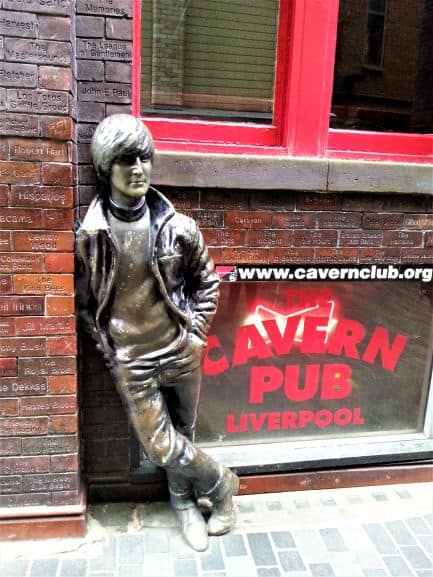
Kansas City/Hey, Hey, Hey, Hey
Even before they became The Beatles, the lads from Liverpool were huge Little Richard fans. John Lennon recalled hearing an import 78 rpm record of Richard’s “Long Tall Sally” and “Slippin’ and Slidin'” when he was a kid. Paul McCartney impressed John with a medley of Little Richard songs when he auditioned to join John’s group.
Later, The Beatles were star struck when they opened for Little Richard in 1962. The singer has often complained that the Fab Four stole his signature “whoo” for early Beatles hits like “I Saw Her Standing There” and “Twist and Shout.”
“Kansas City” was a Leiber and Stoller song that Little Richard paired with his own “Hey, Hey, Hey, Hey” in his live shows. The Beatles loved this number and added it to their repertoire, playing it regularly during performances in 1962 and into 1963.
When the band played a show at Kansas City’s Municipal Stadium on September 17th, 1964, they decided to bring back the tune. The song was so well received in KC, that The Beatles recorded it for their album “Beatles for Sale,” released at the end of 1964.

As far as Muni Stadium goes, it was used as a baseball, football, and soccer stadium until 1976. Perhaps the most famous athlete to play there was Jackie Robinson who was a member to the Kansas City Monarchs during the 1945 season, although during this time the earlier incarnation of the stadium was known as Blues Stadium.
Municipal Stadium was demolished in 1976, replaced by the Municipal Garden and single-family homes. There is a plaque at 22nd and Brooklyn where the stadium once stood. The Negro Leagues Baseball Museum is only about a 15 minute walk from there.
Ticket To Ride
“Ticket To Ride” was released as a single in April, 1965 to promote the forthcoming film and album “Help!” The song was a worldwide hit, reaching number 1 in the U.K., the U.S. and around the world.
The meaning of the song isn’t entirely clear. Paul has said that he and John would visit his cousin on the Isle of Wight. To get there, they would buy a British Railways ticket to the town of Ryde, and the ticket to Ryde was changed to “Ticket To Ride.”
However, this is probably another case of Paul whitewashing the truth to preserve The Beatles squeaky-clean image.
In the early 60’s when The Beatles played shows in Hamburg, Germany, they prowled the streets of the Reeperbahn. Prostitutes also frequented the area. These ladies carried cards issued by the local health department showing that they were free of venereal diseases. Lennon supposedly dubbed these cards a “Ticket To Ride.”
There’s no Beatles sites on the Isle of Wight, though John, George, and Ringo were in attendance at the second Isle of Wight festival in 1969. There was speculation that they might get up and jam with Bob Dylan, but that never came to pass.
Paul McCartney, who was in London during the 1969 fest for the birth of his child Mary, did actually play the Isle of Wight festival in 2010. The concert was held on June 13th at Seaclose Park, making Paul the only Beatle to play on the island.
“Ticket to Ride” is featured in The Beatles’ second film, “Help!” As the song plays, the Fabs goof around on a snowy mountain. They ski, wipe out, and generally have some good-natured Beatle (and in some cases stunt double) fun on the slopes at Obertauern in the Austrian Alps.
While filming in Obertauern, John and Paul dropped in at the Hotel Marietta. Jacky Spelter and his band Jacky and the Strangers were playing a gig at the hotel.
John and Paul knew Jackie from their days in Hamburg so they sat in for a few songs. John cranked up his amp and the hotel manager soon pulled the plug on the show.
No, not because it was too loud, but because he had booked Jacky, not The Beatles!
Eleanor Rigby
The Beatles began the sessions for what would become the album “Revolver” in April, 1966 and completed work in June. When “Revolver” was released in August, it was apparent that The Beatles had made another great leap forward musically, building on the innovation and creativity of their last album “Rubber Soul.”
“Eleanor Rigby” was released as a single with “Yellow Submarine” and reached #1 on the British charts. It only went to #11 in America, where “Yellow Submarine” was more popular.
While Paul McCartney wrote most of the song, he did receive some help with the lyrics from John, George, and Ringo. Even Pete Shotten, a childhood friend of Lennon’s who often hung out with the band, helped with the song’s narrative and suggested that the name of the priest be changed from Father McCartney to Father McKenzie in order to avoid confusion with Paul’s dad.
Paul has said that the name “Eleanor Rigby” was a nice sounding combination of Eleanor Bron, an actress who starred with The Beatles in “Help!”, and Rigby & Evens Ltd, Wine & Spirit Shippers, a store in Bristol.
However, there was a real Eleanor Rigby. And, she’s from Liverpool!
The real Eleanor Rigby died at age 44 in 1939 and was buried in the graveyard of St Peter’s Parish Church. This is the church where John and Paul first met in 1957 and where the pair would often sunbathe in the summer.
Paul has said, quite understandably, that he could have subconsciously retained the name Eleanor Rigby from his childhood.
Eleanor Rigby’s gravestone and the church are tourist attractions for Beatle People from around the world, due to the site’s historical significance. There is also an Eleanor Rigby statue on Stanley Street in Liverpool. Sculpted by 1950’s singer Tommy Steele, he unveiled his statue on December 3rd, 1982.
She Said She Said
In 1965, The Beatles were on tour and in need of a break. Manager Brian Epstein rented the house at 2850 Benedict Canyon Drive in Beverly Hills for a six day respite for the group. The address became public knowledge and soon fans were swarming the area and streets were blocked off. Police were called in to restore order and protect the boys.
Once again, The Beatles were prisoners of their own fame. Unable to leave, they invited friends over. Actress Eleanor Bron (see above) and singers Joan Baez, Roger McGuinn and David Crosby all dropped by.
Peter Fonda joined the party on August 24th. Everyone, it seems, was high on LSD except for Paul, who refused to partake. George was having a bad trip and thought he might be dying. Fonda tried to reassure him by saying “I know what it’s like to be dead.” Of course, Fonda’s talk about death didn’t help and George spiraled further. This upset John who said to Fonda “Who put all that shit in your head?” and “You’re making me feel like I’ve never been born.”
These phrases became the building blocks for the lyrics to “She Said She Said.”
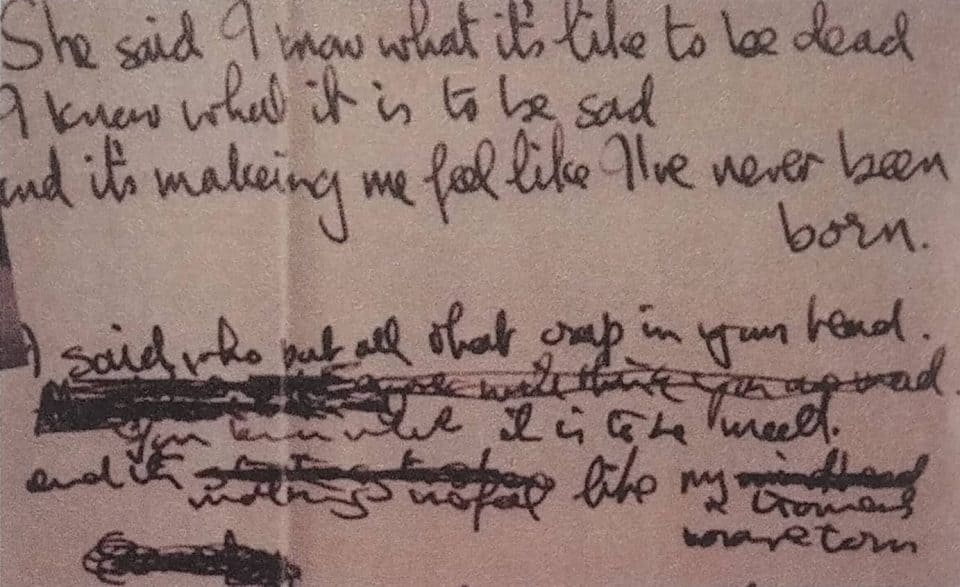
Lennon began working on a song, originally called “He Said,” in March 1966. George Harrison helped with composing it, even though it is credited as a “Lennon-McCartney” number.
“She Said She Said” is also unusual in that George plays bass on the song. Paul, perhaps feeling alienated from the rest of the group because of his refusal to try LSD, walked out on the session. Or, it could be that Paul didn’t care for the subject matter in the song.
The house at 2850 Benedict Canyon Drive is still a private residence and was sold in 2013. Estimates are that it is worth about $4 million today.
Doctor Robert
The Beatles were enthusiastic recreational drug users.
The lads popped pills in Hamburg in an effort to keep their energy up and “Mach schau” (put on a show!) during grueling 8 hour performances.
Later, they experimented with marijuana and LSD. John’s withdrawal from heroin is excruciatingly told in his song “Cold Turkey.”
The idea for “Doctor Robert” may have been sparked in Lennon’s mind when Mick Jagger came to visit The Beatles in the studio. The Beatles were working on “Revolver” and the Rolling Stones had recently released “Aftermath.” John and Mick supposedly discussed “Mother’s Little Helper,” another song with overt drug references.
There’s been quite a bit of speculation about the real identity of Doc Robert. Some say it was Bob (Robert) Dylan who first introduced the boys to weed in 1964.
Others cite Dr. John Riley. The dentist spiked John and George’s coffee with acid during a dinner party.
Or, maybe it was Robert Fraser, a good friend of The Beatles. “Groovy Bob” was a London art dealer and art director who was known for supplying weed and cocaine to his swinging clients.
Then, there’s Dr. Robert Freymann. German-born Freymann was known for liberally dispensing B-12 shots mixed with amphetamines to the rich and famous.
There’s no evidence that John or the other Fabs visited Dr. Freymann, but Lennon seemed enthralled with the story. His friend Pete Shotton said John was giddy with the thought that fans would be singing along to his druggie song.
Freymann’s “Dr. Feelgood” clinic at 3 E 78th Street in New York City is now home to multi-million dollar condos.
Most agree that Freymann was the real Dr. Robert. Then again, it could have been Lennon himself. John claimed he was the bagman during early Beatles’ tours, responsible for holding the pills that fueled the band on the road.
Strawberry Fields Forever
The songs “Strawberry Fields Forever” and “Penny Lane” were recorded at the beginning of the “Sgt. Pepper” sessions, but were not included on that album. Instead, they were issued as a double A-side single in 1967. Both songs were worldwide smashes with “Penny Lane” going to number 1 in the U.S. and “Strawberry Fields Forever” reaching number 8.
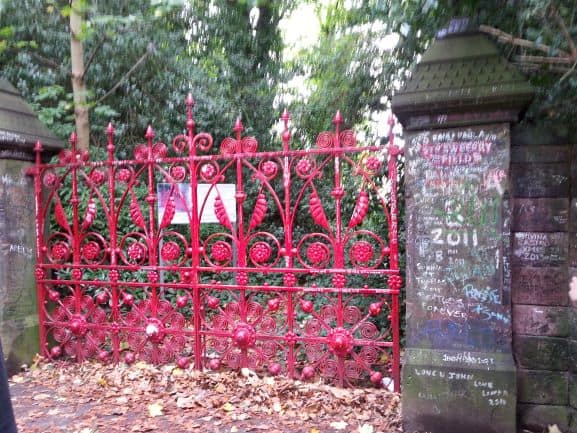
Both songs are also real places in the Fab’s hometown of Liverpool.
John Lennon was raised mainly by his Aunt Mimi. Her house, Mendips on Menlove Avenue, is a short walk from Strawberry Fields. In fact, John could see Strawberry Fields from his bedroom window.
John and his friends would often play at Strawberry Fields, which was a Salvation Army home for orphaned or destitute children. The story goes that John’s rambunctious behavior led to his being banned from Strawberry Field. The head of the home told Aunt Mimi that if John ever returned, he would hang him. That’s where the line “nothing to get hung about” comes from.
Strawberry Fields itself operated as a children’s home until 2005, when it closed. The site has long been a pilgrimage spot for fans, the large red gates being a great spot for a selfie and the walls decorated with graffiti.
After a long period of negotiation and work, Strawberry Fields was reopened in 2019 due mostly to the efforts of John’s half sister Julia Baird. There is an exhibition about Strawberry Field’s history along with a cafe and gift shop on site.
Strawberry Fields also operates a program to assist young people with learning disabilities secure gainful employment.
In New York City’s Central Park, there is a 2.5 acre memorial to John also named Strawberry Fields. The site was dedicated in 1985 and is one of the most popular attractions in the city. Fans will often leave flowers at the mosaic which spells “Imagine.”
Penny Lane

Flip over “Strawberry Fields” for Paul’s take on growing up in Liverpool. He name checks several landmarks in the city.
Penny Lane itself is a street in Liverpool, but it’s also a bus stop. That’s the “shelter in the middle of a roundabout.” The shelter still stands, but it was converted into a restaurant which closed several years ago and now stands vacant.
And what about the “pretty nurse” “selling poppies from a tray”? Her name was Beth. She was a childhood friend of Lennon’s and wound up marrying another of John’s childhood friends, Pete Shotton. Unfortunately, Beth died at the young age of 35.
The most famous barbershop in the history of recorded music is the Tony Slavin Ladies & Gentlemen Salon. This is where the “barber showing photographs of every head he’s had the pleasure to have known” is still located. Paul returned to Liverpool in 2018 for an episode of Carpool Karaoke with James Corden. They visited the barber shop and the reactions of the workers are priceless.
Paul has said that the “banker with a motorcar” was a made-up character. And, he’s never said which bank in Penny Lane inspired him to create that poor soul as there were a couple banks in the area. But, it’s likely to have been the bank located at the corner of Cronton Drive and Smithdown Place. Paul would’ve seen this bank while waiting for a bus at the “shelter in the middle of the roundabout.” Today, the bank is a medical facility.
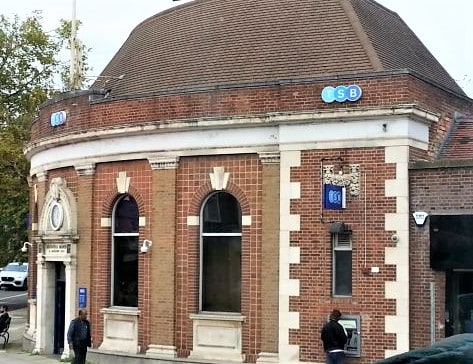
The fire station where Paul describes the “fireman with an hourglass” isn’t actually on Penny Lane, but up the road a bit.
Fans of the Fabs can often be seen seen taking pictures of themselves at all these sites as well as street signs marking Penny Lane.
Being for the Benefit of Mr. Kite
“Penny Lane” and “Strawberry Fields Forever” were recorded with the intention of including them on The Beatles next album, “Sgt. Pepper’s Lonely Hearts Club Band.” However, record company pressure forced the band to release it earlier than planned as a double A-side 45.
The Beatles also filmed promotional films for both songs. Promotional films were early versions of what are known today as music videos.
You might expect that since both “Strawberry Fields” and “Penny Lane” were about Liverpool, the promotional films for the songs would be filmed there. However, there is only brief images of the city and a bus (sans Fabs) in the “Penny Lane” clip. Instead, The Beatles went to nearby Sevenoaks, Kent for filming.
While there, John dropped into an antiques shop in Sevenoaks. Some have claimed the shop was located at 44a High Street in Sevenoaks, but this hasn’t been confirmed. Lennon was taken by a Victorian-era poster advertising a performance of Pablo Fanque’s Circus Royal in Rochdale.
John bought the poster, hung it in his house, and used it as inspiration for “Being for the Benefit of Mr. Kite.”
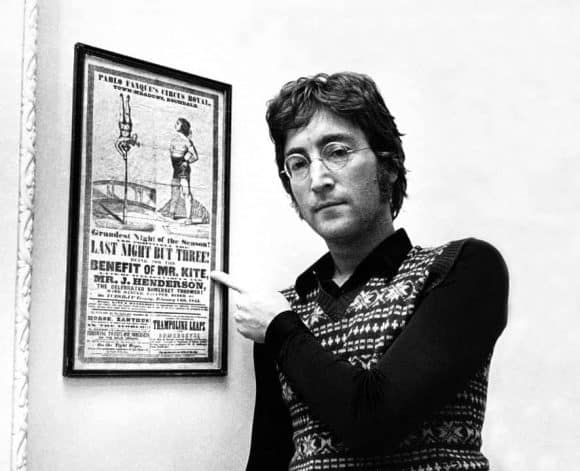
The characters from the song are all on the poster. Mr. Kite was William Kite, a famous circus performer. And, one Mr. J. Henderson, another famous circus performer is also listed on the poster.
That begs the question, if Mr. J. Henderson’s name is on the poster, why did John sing “The Hendersons will all be there”? It turns out that J. Henderson did perform with his wife, forming the plural “Hendersons” act. But, how could John have know this?
As for “Henry the Horse dancing the waltz,” John took the liberty of changing the horse’s name. On the poster he is listed as “Zanthus.” Good call on that one.
The actual performance advertised on the poster took place on February 14th, 1843 in the Town-Meadows of Rochdale.
When I’m 64
“When I’m 64” was released as part of the album “Sgt. Pepper,” but the song’s origin can be traced back several years.
Paul was just 15 years old when he joined John’s band The Quarrymen in 1957. One of his first compositions was “When I’m 64.” Paul was just 16 years old when he wrote it.
In their early days of performing, The Beatles would often play the song when their amps blew or the electricity went out. But, by the time Beatlemania took over, the song had been shelved.

While working on the sessions for what would become “Pepper,” the song was revived. Perhaps it was due to the fact that Paul’s father had just celebrated his 64th birthday.
The cute and bouncy tune includes a mention of the Isle of Wight, where the couple could “rent a cottage.” Paul had a cousin on the famous vacation destination that he and John would sometimes visit. The other three Beatles were in attendance, but didn’t perform, at the 1969 Isle of Wight Festival (Paul was in London for the birth of his daughter). Paul did finally play the Isle of Wight Festival in 2010 at Seaclose Park, making him the only Beatle to have ever played there.
A Day in the Life
Pepper’s last track is undoubtedly it’s finest. “A Day in the Life” is not only a great rock song, but also a great leap forward in popular music. The avant-garde orchestration and dreamy lyrics combine to create a crescendo of a final chord that lasts an unprecedented 40 seconds.
The lyrics for ADITL don’t follow a standard narrative because John developed the song from different sources. Paul added the middle eight “woke up, fell out of bed” part adding to the disjointed story.
Tara Browne, heir to the Guinness fortune, died in a car accident in December 1966. He was with his girlfriend, speeding and drunk. He didn’t see a traffic light and slammed into a truck in the South Kensington section of West London at Redcliffe Square & Redcliffe Gardens. Browne was 21 years old.
On January 17, 1967, John was reading a newspaper article in the Daily Mail about the court battle over Browne’s children. Recalling the car accident, he wrote “He blew his mind out in a car. He didn’t notice that the lights had changed.”
Paul has said he thought the lyric was about a politician getting high, probably because of the line “Nobody was really sure if he was from the House of Lords.” Tara Browne’s father was a member of the House of Lords, which could explain that line.
In the same edition of the Daily Mail, John read an article about potholes in the town of Blackburn, Lancashire. Inspired, Lennon wrote “I read the news today, oh boy. Four thousand holes in Blackburn, Lancashire.” Then he added one of the most psychedelic lines in music history. “They had to count them all. Now they know how many holes it takes to fill the Albert Hall.”
Royal Albert Hall was opened by Queen Victoria as a concert hall in 1871. It has hosted everything from classical music concerts to ballet to tennis tournaments to rock concerts (Led Zeppelin, The Who, Eric Clapton).
On November 29th, 2002, Albert Hall hosted the Concert for George, a memorial concert in remembrance of George Harrison. Bandmates Paul McCartney and Ringo Starr performed along with friends Tom Petty, Jeff Lynne, Eric Clapton, Billy Preston, Ravi Shankar, and members of Monty Python.
I Am the Walrus
After “Pepper,” John continued his experimentation with avant-garde music on “Two Virgins,” a solo album he made with Yoko Ono, and “Revolution 9” from The White Album.
Lennon’s exploration of psychedelic music culminated with “I Am the Walrus.” Like “A Day in the Life,” “I Am the Walrus” was the result of combining the pieces of several other ideas.
John took part of the rhythm of the track after hearing a police siren near his house. He had another idea for a song about “Sitting in an English garden.” Then, there was another piece about “Sitting on a corn flake, waiting for the man to come,” which was later changed to “van to come.”
Unable to complete each piece as its own song, Lennon combined the fragments into a disjointed story. Pete Shotton, John’s friend, reminded him of an old schoolyard poem they recited as kids and “Yellow matter custard, dripping for a dead dog’s eye” was incorporated into the lyrics.
Then, there’s the nonsensical “Semolina Pilchard” who was “Climbing up the Eiffel Tower.” It’s likely John was referring to Norman Pilcher, a drug squad police officer. Pilcher was notorious for busting rock stars like Mick Jagger, Keith Richards, and Eric Clapton.
Pilchard also busted John and Yoko when they were staying at Ringo’s house in 1968. Later, he arrested George and Patti Harrison on drug charges in 1969.
But, “I Am the Walrus” was written in 1967, before Pilchard arrested them. That’s how well-known Norman Pilchard was to the Swingin’ Sixties crowd. A few years later, Pilchard was tried for planting evidence on the people he had arrested. He was found guilty, resigned from the police force, and served four years in jail, undoubtedly proving John and George’s claims that they had been set up.
When it comes to the Eiffel Tower, there are pictures of the Fab Four with the landmark in the background, but no evidence they ever went to the top. However, The Beatles have a history with the City of Light.
John had received some money from a relative for his 21st birthday, so he and Paul decided to hitchhike to Spain. They never made it past Paris, but had a great time, according to Paul.
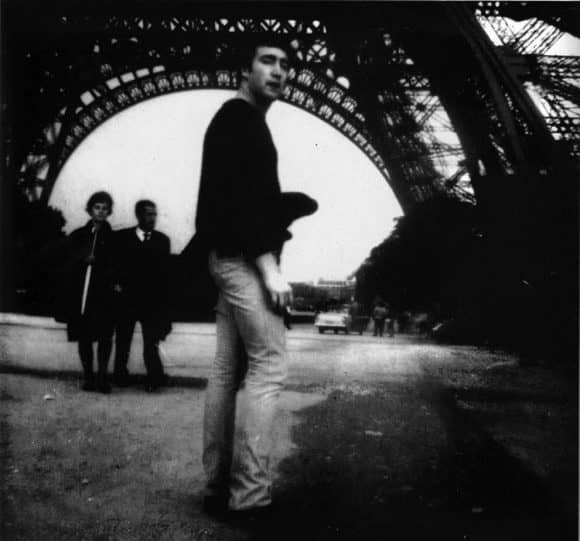
John and Cynthia (John’s first wife) had a belated honeymoon in Paris in 1963.
In January, 1964, The Beatles played a 3 week engagement at the Olympia Theater, a venue that still holds concerts in Paris. It was during this time that Brian Epstein received word that “I Want To Hold Your Hand” had gone to number 1 in the States. A couple weeks later, the boys would perform on the Ed Sullivan show, igniting worldwide Beatlemania.
The next year, The Beatles returned to Paris to play the larger Palais des Sports (now the Dôme de Paris). They played two shows on June 20th, one at 3pm and another at 9pm. After the show, the boys went to the Castel nightclub. Castel reopened recently as a members-only club.
Blue Jay Way
George Harrison and wife Patti Boyd arrived for a week’s stay in California on August 1st, 1967, smack dab in the middle of the Summer of Love and two months after the release of “Sgt. Pepper.” George rented a house in the Hollywood Hills at 1567 Blue Jay Way.
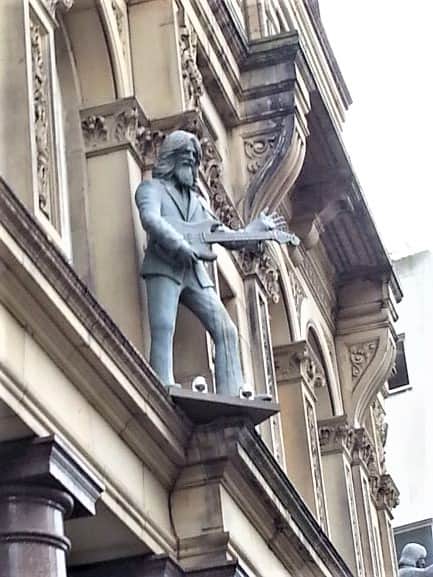
Derek Taylor, The Beatles former press agent who was working in California for The Byrds and Beach Boys, and his wife were due to meet George and Patti at the Blue Jay Way abode. A dense fog was blanketing L.A. and the Taylors were running quite late.
George was extremely jet-lagged and to fight off sleep as he waited for his friend, he began composing a song on a Hammond Organ. By the time Derek and Joan Taylor finally arrived two hours later, “Blue Jay Way” was nearly complete.
The house is still standing at 1567 Blue Jay Way and was sold in 2013 for $3.8 million. Its currently estimated to be worth over $5 million.
The rest of the Harrison’s trip to California was hit and miss. George enjoyed catching up with his friend Derek and also spent time with his sitar mentor Ravi Shankar, helping him to promote an upcoming Hollywood Bowl concert.
But, a side trip to San Francisco’s Haight-Ashbury neighborhood was a big disappointment. Rather than seeing the promised Summer of Love hippies following their artistic muse, he found scam artists and hypocrites.
This experience led to George renouncing LSD and attending Maharishi Mahesh Yogi’s Transcendental Meditation seminar in Wales later that month. Of course, this would lead to other problems down the road (see The White Album).
The song “Blue Jay Way” was released on the EP (U.K.) and LP (U.S.) “Magical Mystery Tour” at the end of 1967. The song was also featured in the critically panned but now cult favorite TV special “Magical Mystery Tour.”
Back in the U.S.S.R.
By late 1967, the British economy was in turmoil. The pound was devalued, interest rates were rising, and taxes were increasing, as was the national debt.
A Conservative member of Parliament suggested that Brits should work the first Saturday of each month without pay to boost productivity. Shockingly, some workers agreed, and began working extra hours for free. The campaign gained momentum, was endorsed by Prime Minister Harold Wilson, and was stamped with motto “I’m Backing Britain.”
In January of 1968, “I’m Backing Britain” was widely popular and Paul McCartney started writing a song called “I’m Backing the U.K.”
The next month The Beatles were in India for an intense course on Transcendental Meditation with Maharishi Mahesh Yogi. By then, Paul’s song had changed to “I’m Backing the U.S.S.R.” borrowing from Chuck Berry’s “Back in the U.S.A.”
Paul used the song to tell the story of a Russian spy who, upon returning to his homeland, waxed poetic about all he had missed while on assignment in the west.
Mike Love of the Beach Boys was also present at the TM retreat in India. He says Paul played the work in progress “U.S.SR.” song and claims he told him to add a section on Russian girls in the mold of the Beach Boys hit “California Girls.” Sexy lines about Ukraine and Moscow girls as well as a reference to the Soviet republic of Georgia were added.
Between the writing of the song and its release on “The Beatles” (aka the White Album), the 500,000 Soviet troops invaded Czechoslovakia and crushed the Prague Spring. In the process, 137 Czechs an Slovaks were killed by the invading army.
Because of this brutal crackdown, public sentiment was strongly anti-Soviet and anti-Communist when “Back in the U.S.S.R. was released. Many right-wing, and a some left-wing, politicians, journalists, and pundits denounced the song.
What they missed is that “Back in the U.S.S.R.” is a satire, both of western culture and life behind the Iron Curtain. It also takes a poke at nationalism and the idea that everything is better back home.
The Beatles never performed in the Soviet Union or in any Communist county. But, in the 60’s, there was a rumor that The Beatles, on their way to Japan, had landed in a Russian city to refuel. While waiting on the tarmac, the boys got on the wing of the plane and gave an impromptu concert. The story, of course, is ridiculous, and utterly charming.
In 1979, however, Elton John did perform several concerts in the U.S.S.R. He closed each show with Paul’s “Back in the U.S.S.R.” to the delight of fans and chagrin of party leaders.
Paul released the album “Снова в СССР” (“Back in the U.S.SR.) in 1988. The album was originally only released in Russia, but demand forced worldwide release in 1991. The record is comprised of rock and roll songs from Paul’s youth, including “Kansas City” which The Beatles released on “Beatles for Sale.”
Paul McCartney finally played Moscow’s Red Square on May 24th, 2003. It was no surprise that “Back in the U.S.S.R.” was included in the setlist. The performance was released as “Paul McCartney in Red Square” in 2005.
Glass Onion
The Beatles songwriting skill improved tremendously with each record. By the time “Rubber Soul” was released in 1965, their fan base had expanded beyond screaming teenage girls. College students and intellectuals took the band seriously and poured over lyrics for hidden meaning.
John, the iconoclast, delighted in tossing red herrings and meaningless couplets into his songs, just to confuse would-be lyrical sleuths. “I Am the Walrus” was one such example. “Glass Onion” was another.
“Here’s another clue for you all, the Walrus was Paul” is meant to be intentionally confusing. John said he liked the poetry of the line, nothing more. Later, however, the lyrics to “Glass Onion” were used to support the “Paul is dead” conspiracy theory.
John, as usual, was just kicking up dirt. He had no intention of this being part of the crazy hoax, although he may have been aware of the crazy “Paul is Dead” story when he wrote the song.
“Glass Onion” also makes a callback to Strawberry Fields (see above). He also mentions another Liverpool landmark “cast iron shore.”
The cast iron shore or “Cazzy” as it is called, is the shoreline on the Mersey River in south Liverpool. The place supposedly gets its name from a nearby iron foundry. Others claim it is named because ships were scrapped nearby and their rust turned the beach red.
Honey Pie
By May, 1968, The Beatles had returned from their trip to India (see below) and were ready to start recording. They worked on many of the songs they had written in India at George Harrison’s house in Esher. There, they recorded demos of 27 songs. Many of these songs were written in India and 19 would wind up on “The Beatles” (aka The White Album).
“Honey Pie” was one of those songs recorded in demo form at Kinfauns, George’s bungalow home in Esher. However, “Honey Pie” wasn’t written in India and has a very different feel than the rest of the songs on the record.
The tune is in the British Music Hall style that was popular in the Victorian era in England. Paul’s father loved Music Hall songs and Paul wrote several in that style including “When I’m 64,” “Your Mother Should Know,” and “Honey Pie.” A scratchy 78 rpm record sound effect was added to the final recording of “Honey Pie” for further authenticity.
The lyrics mention several places like the “north of England,” “the U.S.A.,” and “Hollywood,” but only in general terms. Unfortunately, the bungalow at Kinfauns, which should be an historic landmark, was demolished in the 70’s to make room for a new two-story house.
The Ballad of John and Yoko
Shortly after divorcing Cynthia Lennon, John married artist Yoko Ono in Gibraltar on March 20th, 1969. While honeymooning in Paris, John began composing “The Ballad of John and Yoko.” The song tells the story of John and Yoko’s marriage in a road trip narrative, complete with the places they visit along the way.
Lennon mentions the docks of Southampton in the song. He went here to inquire about being married at sea. His plan was to marry Yoko on the ferry to France and be wed when they docked. However, they weren’t allowed to marry on the boat, so they chartered a plane to Paris instead.
“Peter Brown called to say
You can make it O.K.
You can get married in Gibraltar near Spain”
Brown worked for The Beatles’ company Apple Corp., acting as the band’s de facto manager after Brian Epstein’s death. Brown arranged for John and Yoko to charter a plane to Gibraltar. Since Gibraltar is a British Overseas Territory, John was allowed to marry Yoko on short notice at the British Consulate Office. Registrar Cecil Wheeler performed the ceremony and Peter Brown acted as witness.
When “The Ballad of John and Yoko” was released, it was banned by many countries and radio stations due to the use of the words “Christ” and “crucify.” However, the fascist Franco government banned the record because Spain still views Gibraltar as Spanish territory.
For the 30th anniversary of John and Yoko’s wedding, Gibraltar issued a commemorative postage stamp.
After the quickie ceremony, they flew back to Paris to continue “Honeymooning down by the Seine.” Actually, the couple stayed at the 5 star Plaza Athénée hotel in Paris’ 8th arrondissement. The hotel is still in operation and has a fancy restaurant, Alain Ducasse au Plaza Athénée, on site.
On the morning of March 25th, John and Yoko “drove from Paris to the Amsterdam Hilton.” Here, J&Y held their first bed-in for peace. The idea was to use the press coverage they would receive for their marriage and turn it into a “commercial” for peace.
The couple was met with ridicule, contempt, and racism. But, they still spent several hours each day talking to reporters and repeating their message of peace.
John and Yoko stayed in room 902 of the Amsterdam Hilton, but after a remodel, the room was renumbered as 702. Room 702 of the Amsterdam Hilton is the “John and Yoko Honeymoon Suite” and civil wedding ceremonies are performed there.
From Amsterdam, the newlyweds “made a lightning trip to Vienna” to promote Yoko’s film “Rape” which was being premiered on Austrian TV. John and Yoko held a press conference at Vienna’s Hotel Sacher.
Like all things John and Yoko, the press conference was unusual, to say the least. The couple conducted the press conference from inside a large bag which hid their bodies and faces. Lennon said the bag promoted “total communication” because the reporters could not judge them by their appearance. This was the first instance of John and Yoko’s concept of “Bagism,” a satire of prejudice and stereotyping.
J&Y stayed overnight at Hotel Sacher, enjoying their famous Sachertorte. Thus, “eating chocolate cake in a bag.”
Two week’s after returning from Vienna, John brought “The Ballad of John and Yoko” to Paul’s house. John and Paul worked on the song together, like the old days, which was a nice departure from the tension of recording The White Album.
Paul cautioned John about the “Christ” and “crucify” lyrics. John paid no heed and the two headed to EMI Studio that same day to record the track. Since Ringo was off filming the movie “The Magic Christian” and George was on holiday, John and Paul play all the instruments on “The Ballad of John and Yoko.” Paul handles bass and drums while John is on lead and acoustic guitar.
Upon release, the song, as Paul had feared, was banned by many influential radio stations because of the lyrical content. But it still shot to number one worldwide in spite of (or, perhaps, because of) the ban.
Maggie Mae
The recording sessions for the album “Let It Be” we riddled with tension. George, at one point, left the group. Rampant drug use didn’t help the environment, either.
While noodling in the studio, the band would often play some of their favorite folk songs or rock and roll classics by the likes of Chuck Berry, Buddy Holly, or Fats Domino.
One of these songs was old Liverpool folk song “Maggie Mae.” The song dates back 200 years but The Beatles likely knew it from the 1950’s when “Maggie Mae” was a popular skiffle song.
The Beatles only sing a snippet of the song. At 39 seconds, it is the second shortest song in The Beatles catalog (“Her Majesty”).
The lyrics tell the story of a prostitute who robs a sailor flush with cash after a time at sea. She is sentenced to prison, guaranteeing that she’ll “never walk down Lime Street any more.”
Lime Street is one of the main streets in Liverpool. The lyrics also mention “port of Liverpool” which is a huge system of docks in the city.
Royal Albert Dock is part of the port of Liverpool. Today, the Royal Albert Dock is where tourists board the Magical Mystery Tour bus to see Beatle sites in Liverpool. It is also home to The Beatles Story museum.
Get Back
On January 2nd 1969, The Beatles began work on what would become the “Let It Be” album. John and George were hardly in the mood to be there. The conflicts from The White Album sessions had not been resolved and John was in a spiral of heroin addiction.
The sessions were unfocused, at best, often with one member, mainly Paul, trying to interest the others into playing one of his songs. Other times they loosely jammed on oldies from their days playing Hamburg or The Cavern Club.
On January 7th, the group was jamming on “Sour Milk Sea.” George had written the song in India and the band demoed it at his house in Esher, thinking it might be a part of The White Album. When that didn’t happen, George gave the song to Jackie Lomax, a Liverpool singer signed to The Beatles’ Apple label.
During the January 7th jam session, Paul improvised some new lyrics to George’s song, singing “Get back to where you once belonged.” Paul must’ve liked this because on January 9th he had developed “Get Back” further by adding the “Sweet Loretta” verse and a near-finished melody.
The next day, January 10th, all the animosity within the group came to a head and George Harrison quit the group. Blame has been laid at the feet of Paul whose authoritarianism in the studio began to wear on George. But, John and George also argued quite often and quite bitterly. In fact, as George was walking out, John coldly suggested the band hire Eric Clapton who was less of a “headache.”
After the George-less Beatles flailed in the studio for a few days, Harrison returned. He brought along old friend Billy Preston who the band knew from their Hamburg days. The move was a shrewd one on George’s part. The Beatles were on their best behavior, wanting to make a good impression on Billy.
With Billy Preston on electric piano, the new five piece band perfected “Get Back,” including the false end and coda.
An early version of the song parodied the anti-immigrant movement led by Member of Parliament Enoch Powell. Racially charged lyrics like “don’t dig no Pakistanis taking all the people’s jobs” were meant to expose the ridiculous views of hyper-nationalists like Powell.
In the end, Paul decided to cut the controversial verse from the song. Likely, he was remembering the backlash The Beatles received over John’s “more popular than Jesus” comments and the banning of the single “The Ballad of John and Yoko.” He must’ve thought that people would misinterpret his intention, too.
In the song, Paul sings about “JoJo” who “left his home is Tucson, Arizona for some California grass.” Paul has said the character is made-up. And perhaps JoJo was a fictional character.
However, it seems more likely that JoJo was actually based on Linda McCartney’s first husband Joseph Melville See Jr. Linda met Melville (he went by his middle name) while she was a student at the University of Arizona in Tucson. They married in 1962 but were divorced three years later.
Paul and Linda remained friendly with Melville over the years, even inviting him to stay at their estate in Scotland on vacation. But, it is possible that when Paul was writing “Get Back” there could have been some underlying resentment. Paul was about to marry Linda and adopt Heather See, daughter of Linda and Melville. It is certainly understandable if there were some difficulties between the two while this situation was playing out.
Paul and Linda bought a ranch in Tucson. Linda died there in 1998. Melville died in 2000, also in Tuscon, of a self-inflicted gunshot wound.
Beatles Albums
The Bealtes (The White Album)
The Beatles wrote many of their songs at home. First in the McCartney home on Forthlin Road in Liverpool and John’s childhood home on Menlove Ave. Although considerably fewer songs were written at Aunt Mimi’s because she couldn’t stand the racket.
Later, they wrote many songs on the road while on tour or at their own homes.
“The Beatles,” commonly known as The White Album, is a major exception.
Just after “Sgt. Pepper” was released, the band’s manager Brian Epstein died. Rudderless, The Beatles released the TV special “Magical Mystery Tour.” This was widely regarded as the band’s first major misfire. Even though the TV show was panned, the songs were still quite strong.
With touring not an option; the band quit the road in 1966, and tired of LSD, The Beatles were looking for something new. They found it in the form of Transcendental Meditation and a petite guru named Maharishi Mahesh Yogi.
In February 1968, all four Beatles, their wives (and, in the case of Paul, his girlfriend) and some associates traveled to Rishikesh to study Transcendental Meditation at Maharishi’s Ashram (spiritual retreat). Leaving the drugs (except marijuana) at home, the group’s intentions seemed serious.
However, John and Paul found the environment stimulating and rather than meditate, they spent quite a bit of time in each other’s rooms writing new songs. The Beatles wrote upwards of forty songs in Rishikesh. Nineteen of them appeared on the White Album including “Back in the U.S.S.R.,” “The Continuing Story of Bungalow Bill.” and “Ob-La-Di-Ob-La-Da.” Other songs written in India appeared on Abbey Road and various solo projects.
The trip to Rishikesh ended abruptly in April when John angrily confronted Maharishi about allegedly sexual impropriety involving some of the other women at the retreat. John and George and their wives stormed off and publicly denounced the Maharishi. Lennon wrote the scathing rebuke “Sexy Sadie” which was originally titled “Maharishi.”
It should be noted that none of the claims against the Maharishi were ever proven and the majority of people at the retreat did not believe the allegations, including Cynthia Lennon (John’s wife), Patti Boyd (George’s wife), and Jenny Boyd (Patti’s sister). Several people, in fact, have come forward and said they believed the allegations were a power play among individuals trying to take down Maharishi.
The Ashram where Maharishi taught TM was abandoned in the 70’s and the surrounding jungle took over. Even so, Beatles fans often trekked to the Ashram and left Beatles-inspired graffiti.
Over the years, several proposals for the site were suggested, but never came to fruition. That is, until 2015, when it was reopened as Beatles Ashram.
Some effort has been made to preserve the deteriorating buildings and artists have painted murals on walls. But, don’t expect fancy tours or museums here. This is a quiet place of meditation (and tagged buildings) that is slowly giving way to nature.
Abbey Road
The Beatles swan song and, arguably, finest hour is named after the studio where they did much of their recording.
However, the album was originally going to be called “Everest” after the brand of cigarettes that Beatles engineer Georff Emerick smoked. But, the idea of flying over Mount Everest to get a photo for an album cover seemed too complicated and time consuming.
So, instead, they boys stepped outside the studio and walked across Abbey Road a few times while a photographer clicked away.
It’s hard to fathom that such an iconic album cover came from that spontaneous decision, but it did. And today, people line up at the street corner on Abbey Road and traipse across, trying to recreate the scene, much to the chagrin of local motorists.
Unfortunately, the studios at Abbey Road are not available to tour. But, those with deep pockets can rent the studio for private events.
About the Author
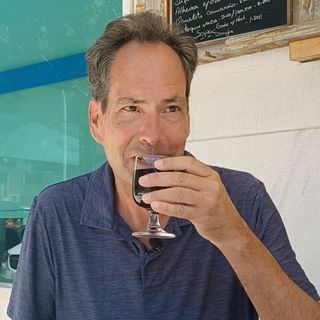
Brent Petersen is the Editor-in-Chief of Destination Eat Drink. He currently resides in Setubal, Portugal. Brent has written the novel “Truffle Hunt” (Eckhartz Press) and the short story collection “That Bird.” He’s also written dozens of foodie travel guides to cities around the world on Destination Eat Drink, including in-depth eating and drinking guides in Portugal to Lisbon, Porto, Sintra, Évora, and Batalha. Brent’s podcast, also called Destination Eat Drink, is available on all major podcasting platforms and is distributed by the Radio Misfits Podcast Network
